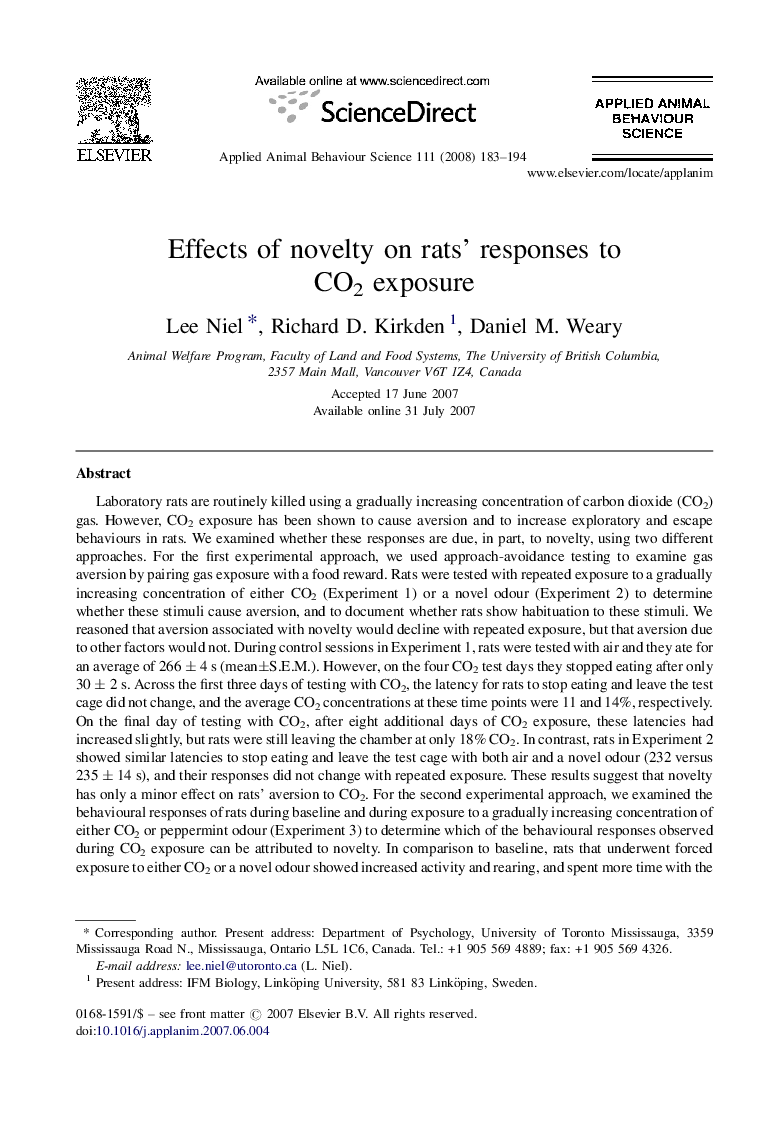| کد مقاله | کد نشریه | سال انتشار | مقاله انگلیسی | نسخه تمام متن |
|---|---|---|---|---|
| 4524032 | 1625423 | 2008 | 12 صفحه PDF | دانلود رایگان |

Laboratory rats are routinely killed using a gradually increasing concentration of carbon dioxide (CO2) gas. However, CO2 exposure has been shown to cause aversion and to increase exploratory and escape behaviours in rats. We examined whether these responses are due, in part, to novelty, using two different approaches. For the first experimental approach, we used approach-avoidance testing to examine gas aversion by pairing gas exposure with a food reward. Rats were tested with repeated exposure to a gradually increasing concentration of either CO2 (Experiment 1) or a novel odour (Experiment 2) to determine whether these stimuli cause aversion, and to document whether rats show habituation to these stimuli. We reasoned that aversion associated with novelty would decline with repeated exposure, but that aversion due to other factors would not. During control sessions in Experiment 1, rats were tested with air and they ate for an average of 266 ± 4 s (mean±S.E.M.). However, on the four CO2 test days they stopped eating after only 30 ± 2 s. Across the first three days of testing with CO2, the latency for rats to stop eating and leave the test cage did not change, and the average CO2 concentrations at these time points were 11 and 14%, respectively. On the final day of testing with CO2, after eight additional days of CO2 exposure, these latencies had increased slightly, but rats were still leaving the chamber at only 18% CO2. In contrast, rats in Experiment 2 showed similar latencies to stop eating and leave the test cage with both air and a novel odour (232 versus 235 ± 14 s), and their responses did not change with repeated exposure. These results suggest that novelty has only a minor effect on rats’ aversion to CO2. For the second experimental approach, we examined the behavioural responses of rats during baseline and during exposure to a gradually increasing concentration of either CO2 or peppermint odour (Experiment 3) to determine which of the behavioural responses observed during CO2 exposure can be attributed to novelty. In comparison to baseline, rats that underwent forced exposure to either CO2 or a novel odour showed increased activity and rearing, and spent more time with the nose touching the cage lid. However, only one of 16 rats performed escape behaviours during exposure to the novel odour, while 10 of 16 rats performed escape behaviours during CO2 exposure. These results indicate that exploratory behaviours observed during CO2 exposure could be due to novelty, but that escape behaviours are not. Both of the experimental approaches indicate that novelty accounts for only a minor portion of rats’ responses to CO2 exposure.
Journal: Applied Animal Behaviour Science - Volume 111, Issues 1–2, May 2008, Pages 183–194